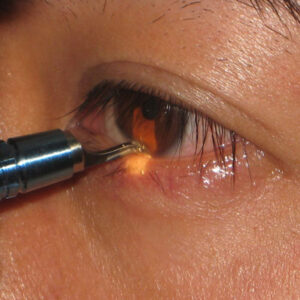Cover Feature: Dry eye/ocular surface
April 2013
by Vanessa Caceres
EyeWorld Contributing Writer
Consider symptoms and treatment alternatives
Glaucoma patients often use a lot of topical drops—so it’s only natural that the medication load can exacerbate ocular surface problems like dry eye.
For this reason, glaucoma specialists need to tailor their care to treat dry eye and related conditions to help patients balance IOP control with a healthier ocular surface.
“Our patients use multiple drops two, three, four, even five or six times a day. That can be aggravating from the base molecule or the preservative,” said Iqbal “Ike” K. Ahmed, MD, assistant professor of ophthalmology, University of Toronto.
Additionally, treatment for retinal conditions such as cystoid macular edema (CME) can, in some patients, make an otherwise stable tear film flare. “Any topical medicine with preservatives in eyes that have dry eye can cause inflammation and changes to the tear film,” said Keith A. Warren, MD, president and CEO, Warren Retina Associates, Overland Park, Kan.
Here’s how glaucoma and retinal specialists manage dry eye with other ocular comorbidities.

In glaucoma: A challenging but common combo
Before starting glaucoma treatment, Dr. Ahmed collects at least some objective and subjective information regarding dry eye symptoms. “I try to get an idea of how bad the ocular surface disease is before we start therapy. It gives us a head start,” he said. On the objective side, he will evaluate tear film breakup time, tear film meniscus, and the patient’s meibomian glands. He will also ask subjective questions to gauge a patient’s symptoms. “By putting that together, there are some rough parameters to see who might develop worse problems,” Dr. Ahmed explained.
Dr. Ahmed may not do a full-scale evaluation with every patient before therapy, but he’ll at least do a cursory review of symptoms. “The problem is dry eye is very common in glaucoma, so it’s hard to say that only certain patients will have this,” he said. At a minimum, he’ll evaluate symptoms during a patient’s initial visit and also when a patient has objective signs of dry eye or any major changes in therapy.
Surgeons need to consider how the medications they are using may make dry eye worse, said Jeffrey M. Zink, MD, Cincinnati Eye Institute, Cincinnati. Often, this can be tied back to medications with preservatives. “Any glaucoma medication can exacerbate existing ocular surface disease, but certainly ones with benzalkonium chloride (BAK) tend to be more involved in causing ocular surface difficulties,” Dr. Zink said. When used over time, BAK is associated with tear film instability, including burning, redness, and irritation in some patients, he said.
Because of this common problem, Dr. Zink will discuss preservative-free glaucoma medications with patients. “We now have a few available, which is wonderful,” he said. Dr. Zink tends to broach this discussion at the onset with patients who have pre-existing ocular surface disease. Although ideally more of his patients would use the preservative-free options, he has to consider the extra out-of-pocket cost for them. “You need to balance how severe the ocular surface disease is and tailor the drop choices to the individual needs of each patient,” Dr. Zink said.

However, when preservative-free options are affordable for patients, they can be less irritating in some cases, which may boost adherence to the drop regimen, he added.
When the toxic load of too many drops is an issue, Dr. Ahmed also considers switching patients to combination drops and using drops that may reduce dosing to only once or twice a day.
Dry eye specialist Robert Latkany, MD, founder and director, Dry Eye Clinic, New York Eye and Ear Infirmary, New York, said it might not just be preservatives that are irritating patients’ eyes. It could also be the drops themselves. “Preservatives or not, these drops can be irritating, and they’re part of the reason for noncompliance,” he said. This especially can occur in patients with ocular rosacea, Dr. Latkany said.
When Dr. Latkany treats glaucoma patients whose eyes appear particularly irritated, he sometimes takes them off all of the drops and starts them back on one at a time. “I’ll recheck their IOP every few days and look at their symptoms,” he said. “If we find one of the drops is irritating, we’ll figure out something else. If I do this in a careful fashion, there isn’t any damage done.” Of course, he suggests this as an approach if a patient has more mild glaucoma versus someone who is in dire need of drops daily.
The growing number of surgical options makes it easier to consider alternatives for dry eye patients irritated by drops, Dr. Zink said. “This is an exciting time in glaucoma because of the promise of microinvasive glaucoma surgery (MIGS) procedures, which could help some of these patients. Even if patients can stop using one drop, that may be important clinically for their ocular surface health,” he said. If a patient has problematic and persistent dry eye problems, Dr. Zink will lean toward laser and surgical options more rapidly than he otherwise might.
Dr. Ahmed also considers surgical options in these patients more often. He said that further MIGS developments and advances in the future in drug delivery options will eventually help these patients.
Dr. Latkany believes it’s a positive trend that there is more awareness now among all ophthalmic specialties about ocular surface complaints. “I think we’re going in the right direction. We’re doing a better job of developing products that are better tolerated,” he said.

Source (all): Ike Ahmed, MD
Retinal concerns
The challenges for retinal surgeons treating conditions such as CME are similar to those that glaucoma surgeons face. Although the medications used might be different, preservatives in medications like topical corticosteroids or non-steroidal anti-inflammatory drugs can irritate the eye surface, Dr. Warren said.
“If there’s significant dry eye, I’ll try to avoid preservative-containing medications,” Dr. Warren said. He’ll consider the use of Durezol (difluprednate ophthalmic suspension 0.05%, Alcon, Fort Worth, Texas), in which the preservative sorbic acid does not irritate the eye as much. He’ll also consider using a periocular injection because that is not administered to the front of the eye.
Dr. Latkany does not see many dry eye patients with CME, but he does see a good number with an aggravated ocular surface after anti-vascular endothelial growth factor injections for age-related macular degeneration. He believes these patients need more careful pre- and postop management of their ocular surface, much like what is done nowadays for refractive surgery and even cataract surgery patients.
When to refer patients to another specialist
In addition to medication management techniques, glaucoma and retinal surgeons often will manage dry eye symptoms with the use of artificial tears, punctal plugs, compresses for meibomian gland dysfunction, or with Restasis (cyclosporine, Allergan, Irvine, Calif.).
Yet there comes a point where they may need to refer patients to corneal specialists.
“If all of those things fail and there’s another comorbidity like anterior basement membrane disease that a cornea specialist could help manage, referring them can be helpful,” Dr. Zink said. “By optimizing treatment for those problems, it often enables patients to tolerate their topical medications.”
Dr. Warren will refer to a cornea specialist when ocular surface symptoms are persistent and do not change with any of his treatment maneuvers. Before a referral, he will try to keep patients on their medication but offer dry eye treatment. If there’s still the occasional flare up, he’ll encourage patients to stay on the medication but increase their use of artificial tears and perhaps add Restasis. If problems still persist, or if the patient has severe dry eye from the start, he’ll consider another treatment approach or refer to a corneal specialist.
Editors’ note
Dr. Ahmed has financial interests with Alcon, AqueSys (Aliso Viejo, Calif.), Glaukos (Laguna Hills, Calif.), Ivantis (Irvine, Calif.), NeoMedix (Tustin, Calif.), and Transcend Medical (Menlo Park, Calif.). Dr. Latkany has financial interests with Alcon. Dr. Warren has financial interests with Alcon, Dutch Ophthalmic Research Center (Zuidland, the Netherlands), and Genentech (San Francisco). Dr. Zink has no financial interests related to this article.
Contact information
Ahmed: 416-625-3937, ike.ahmed@utoronto.ca
Latkany: 212-689-2020, relief@dryeyedoctor.com
Warren: kwarren@warrenretina.com
Zink: 513-984-5133, jzink@cincinnatieye.com



